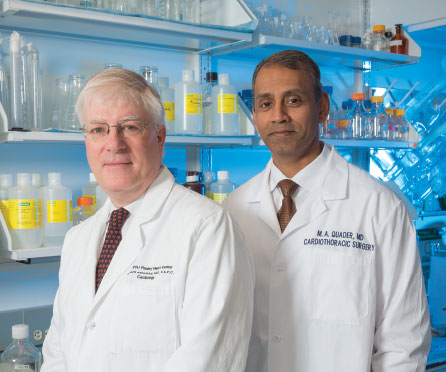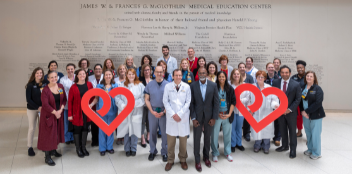Researchers Seek to Reduce Donor Heart Wait

VCU Health Pauley Heart Center physicians and scientists are engaged in research that they hope may answer questions about the viability of certain donor hearts.
One study conducted by Mohammed Quader, M.D., Vigneshwar Kasirajan, M.D., and Luke Wolfe, M.S., of the Division of Cardiothoracic Surgery reviewed data on heart donors who had experienced cardio-pulmonary resuscitation (CPR) before their deaths.
“There are quite a few surgeons who are reluctant to accept hearts for transplantation that have undergone CPR,” says Quader, VCU Health assistant professor and a cardiac/thoracic surgeon.
The group explored whether such concerns were legitimate by analyzing UNOS transplant data from May 1994 to July 2012. Of the 29,242 adult heart transplantations performed in the U.S. during the study period, 1,396 (4.7 percent) had received hearts from donors who had experienced CPR.
After reviewing the data, “we found no difference in the short-term and long-term survival rates of recipients who have received a heart from someone who had undergone CPR versus other who didn’t. That was really very encouraging,” he says.
Published in the Journal of Heart-Lung Transplantation, in November 2013, the study has since received widespread acclaim. “If our work has changed the minds of even 100 surgeons, it will mean at least that many new lifesaving opportunities for patients,” he says.
The study will also have future applications. “This study is the foundation to our ongoing quest to expand donor heart availability by developing better methods of heart preservation and resuscitation,” says Kasirajan, chief of Surgery.
Currently, the wait list for a donor heart can range from three months to three years, depending upon the patient’s blood type and medical condition, says Quader. “The number of donors has plateaued over the last decade, and we are not able to do any more heart transplants than what we were able to do 10-15 years ago. But at the same time, the need for trans-plantation has increased perhaps by 300 percent.”
Quader and Kasirajan are working closely with VCU Health research scientists who are exploring other avenues of reducing donor wait times. Marty Mangino, Ph.D., Edward Lesnefsky, M.D., and Stefano Toldo, Ph.D., are undertaking animal studies to answer a number of questions related to a potential heart donor group, the “Donation after Cardiac Death”— also known as “DCD”— donors.
These are individuals who may not meet the legal criteria of brain death but who have enough brain damage “that in all probability the brain function recovery is almost zero,” says Quader. “Almost all of these patients would have suffered a heart attack during the DCD process.” Currently, the hearts of DCD donors are not used for transplantation, though their longer-surviving livers and kidneys are.
Cardiac donors are generally trauma victims who have experienced brain death but not cardiac arrest. “Circulation is very protective, and there are potential drug treatments that could protect the heart, optimize metabolism and keep the heart going until it is implanted in a recipient,” says Lesnefsky, VCU Health professor and chief of Cardiology at McGuire V.A. Medical Center.
DCD patients, however, experience a loss of blood flow, which injures the heart cells. As a result, “their metabolic pathways—their metabolic wiring, if you will—is damaged.” And, paradoxically, the cells experience further damage when reintroduced into an environment of normal oxygen and blood flow, as is the case with transplantation. “They become metabolically overwhelmed and undergo cell death.”
Through a VCU Health-sponsored animal study, the team is looking into approaches to preserve and perhaps even “rehabilitate” DCD hearts. One approach is that used by Lesnefsky’s laboratory in the study of heart cell injury during an experimental heart attack. This approach modulates or modifies the metabolism of heart cells. They are targeting the mitochondria, the “powerhouses of the cell,” that drive cell death following restoration of blood flow. “Up to 25-35 percent of the cells will die,” he says, during what should be a regenerative time. The team is using a drug that temporarily paralyzes the mitochondria during reflow. “We think our mitochondria-derived treatment prevents a large amount of early cell death that will keep the heart for transplant working well.”
In addition to preventing this acute period of cell death, “one needs to also protect the donor heart recipient against longer-term heart cell loss.” He points to the studies by Antonio Abbate, M.D., Ph.D., and others (see article “New Drug Reduces Injury …” on previous page) into preventing heart failure that may also apply to transplantation. “It’s going to take a comprehensive approach to help these DCD heart grafts work the best and stay the best.”
“About 15-20 percent of the livers and kidneys used are actually from DCD donors,” he says. “If this could expand the amount of available hearts 10-15 percent even, that would be very exciting.”
ABOVE: EDWARD LESNEFSKY, M.D., AND MOHAMMED QUADER, M.D.
Back to Autumn-2015
Join our Pauley Consortium composed of patients, friends and advocates.

